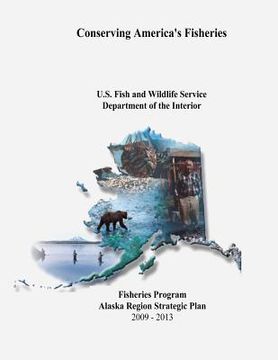Share
Conserving America's Fisheries: Fisheries Program Alaska Region Strategic Plan, 2009-2013 (in English)
Fish And Wildlife Service
(Author)
·
Createspace Independent Publishing Platform
· Paperback
Conserving America's Fisheries: Fisheries Program Alaska Region Strategic Plan, 2009-2013 (in English) - Service, Fish And Wildlife ; Interior, U. S. Department of the
$ 13.59
$ 16.99
You save: $ 3.40
Choose the list to add your product or create one New List
✓ Product added successfully to the Wishlist.
Go to My WishlistsIt will be shipped from our warehouse between
Monday, July 15 and
Tuesday, July 16.
You will receive it anywhere in United States between 1 and 3 business days after shipment.
Synopsis "Conserving America's Fisheries: Fisheries Program Alaska Region Strategic Plan, 2009-2013 (in English)"
In December 2002, the U.S. Fish and Wildlife Service completed its National Fisheries Program Strategic Vision for the Future. That landmark document was developed in collaboration with partners from across the country, including the Alaska Department of Fish and Game (ADF&G), to better define the Service's role in conserving and managing the Nation's aquatic resources. The Vision, because it is national in scope, outlines a number of broad goals and objectives that will focus the efforts of the National Program over two consecutive 5-year periods. Because the aquatic resources and the issues that threaten their status differ among the Service's Regions, the priority of these goals and objectives likewise varies from one part of the nation to another. Alaska shares in many of the same aquatic habitat threats common among the Service's Regions and is arguably America's climate change ground zero- with landscape level effects that are both immediate and visible. The direction outlined in this plan is based largely upon the strategic direction and the lessons we learned in implementing the 2004-2008 regional plan. We believe that many of the conservation and partnership commitments outlined in the previous plan should continue in the coming 5 years, but with modifications based on the lessons we learned along the way, input from our partners, as well as incorporating new challenges and opportunities we see on the horizon. We were not successful in completing every task we identified 5 years ago, but we made substantial progress and achievements for the vast majority of those obligations. Additionally, we worked aggressively at developing 5-year work activity plans for each of our field offices that identifies and prioritizes work activities and fish monitoring projects where aquatic resource threats are most imminent. Our Alaska Fisheries Program has expanded into forming new and stronger external partnerships and has strengthened its role in enhancing internal coordination to support our Fish Passage and Habitat Restoration Programs. Expanded Alaska partnerships under the National Fish Habitat Action Plan (NFHAP) are opening new doors to work with diverse groups interested in conserving and restoring fish habitats where they matter most. As a result of these efforts, we are now better positioned to line out our course of action and formalize new commitments for fisheries and aquatic resource conservation. Our greatest challenge in the coming years is the complex and uncertain impacts anticipated from climate change. Major climatic changes have occurred in recent decades with visible and measurable consequences in Alaska. This overarching conservation issue pays no heed to political or administrative boundaries and will demand a strategic, proactive, creative and collaborative approach. Our approach to addressing climate change will emphasize strategies that support understanding of physical processes occurring across landscapes in Alaska, determine species and landscapes most impacted and develop broad-scale management priorities, implement adaptive management strategies, and reduce our own carbon foot print in our daily work activities. Ultimately, our success at ensuring diverse and abundant fish populations and ecologically functioning landscapes will depend on how quickly we can build needed advancements in our technical capabilities, how well we integrate our efforts with those of our partners and across programs, and how strategic we are with limited resources.

